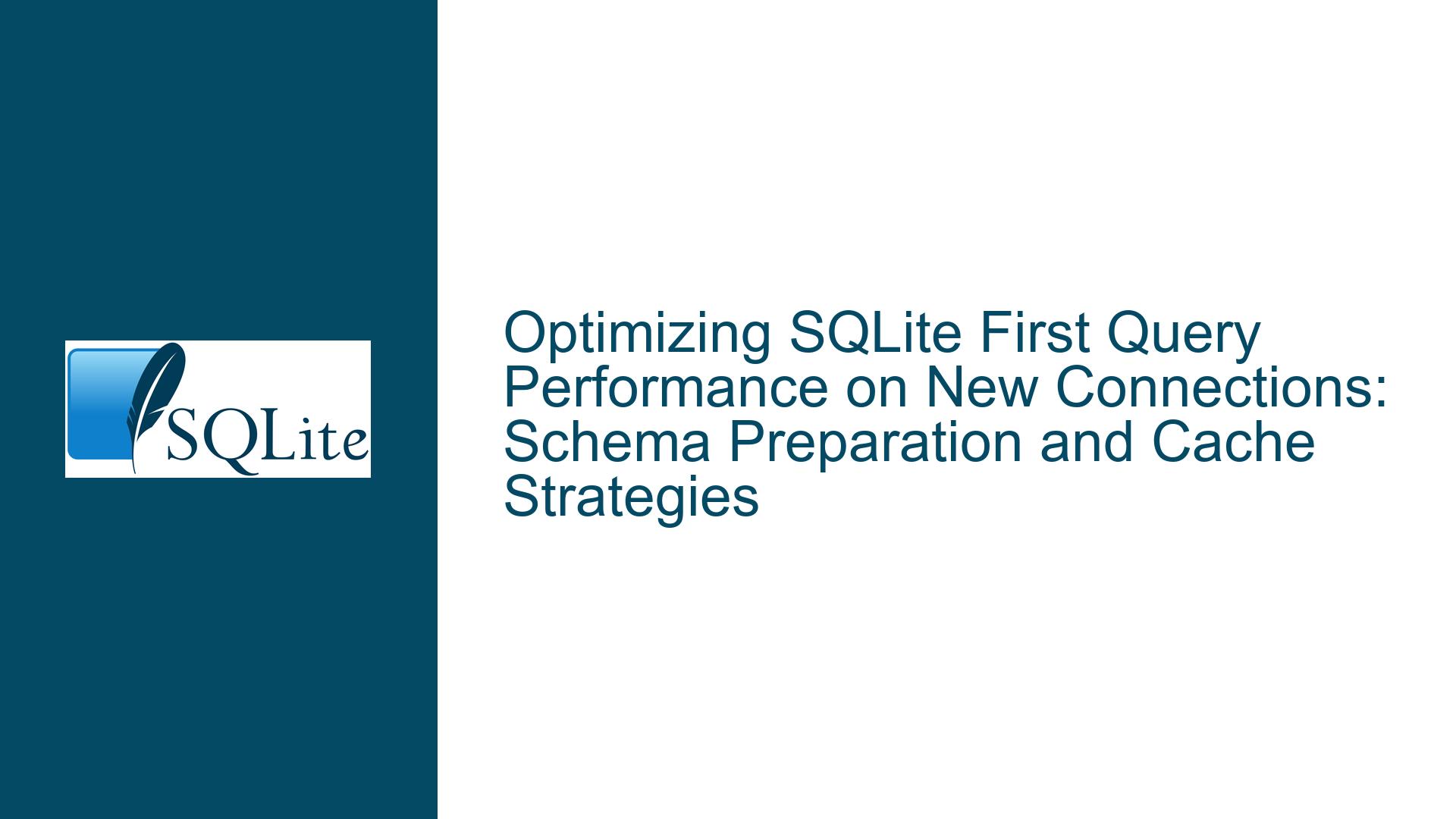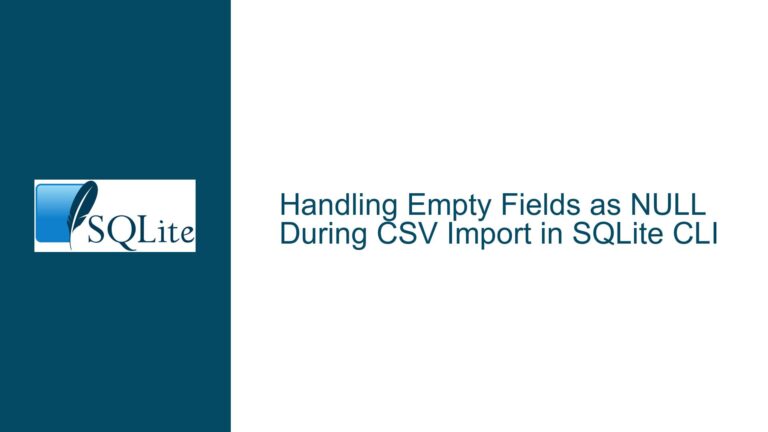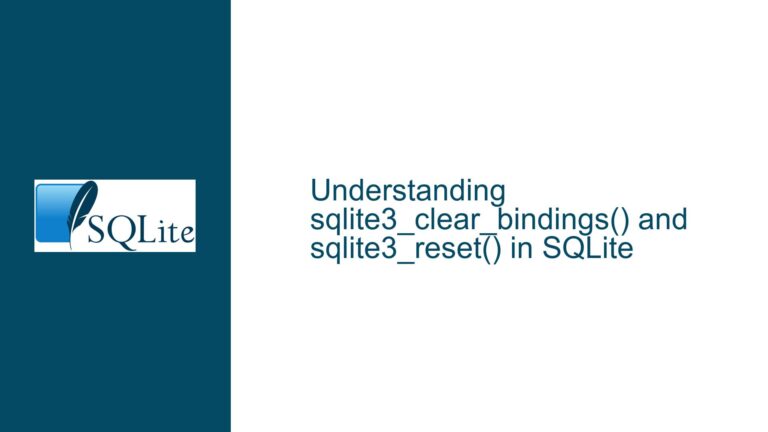Optimizing SQLite First Query Performance on New Connections: Schema Preparation and Cache Strategies
Understanding SQLite’s First Query Latency During Connection Initialization
Issue Overview: Delayed First Query Execution in Fresh SQLite Connections
When establishing a new connection to an SQLite database, users often encounter significant latency during the first query execution compared to subsequent operations. This phenomenon manifests differently across hardware configurations, with older HDD-based systems sometimes experiencing 30-second delays versus sub-second delays on modern SSD-equipped machines. The core challenge stems from SQLite’s initialization requirements, which include schema parsing, index validation, and disk I/O coordination across multiple system cache layers.
At the lowest level, SQLite must read the database header (first 100 bytes) to verify file format validity and read the schema root page. This process interacts with the operating system’s file system cache, storage controller buffers, and physical media characteristics. The database engine then parses the sqlite_schema table (formerly sqlite_master) to build internal representations of tables, indexes, triggers, and views. Missing indexes force SQLite to perform full-table scans during query optimization, compounding initialization delays when schema metadata isn’t properly cached.
The problem intensifies with BLOB handling due to their storage in overflow pages that require separate I/O operations. Incremental BLOB I/O (enabled via sqlite3_blob_open) introduces additional complexity, as the database must locate BLOB pointers in the database file structure before streaming content. On rotational HDDs, random access to scattered BLOB pages creates seek time penalties absent from SSD configurations.
Possible Causes: Schema Parsing, Cache Misses, and Hardware-Dependent I/O Patterns
1. Schema Metadata Loading Overhead
Every new SQLite connection must validate and partially load schema information from the sqlite_schema table. This includes:
- Table structure definitions
- Index existence and composition
- Trigger and view SQL text
- Page allocation metadata
Without proactive schema caching, this occurs on-demand during the first query execution. Large schemas with hundreds of tables/indexes exacerbate the problem, as SQLite must parse and validate each entry’s SQL text. Missing indexes force the query planner to generate alternative execution strategies, adding computational overhead during the critical first query phase.
2. Multi-Layer Cache Hierarchy Mismatches
Modern systems implement caching at four distinct levels:
- SQLite’s page cache (default 2000 pages)
- OS file buffer cache
- Storage controller DRAM cache
- Physical media read-ahead buffers
New connections start with cold caches at all levels. The first query must populate these caches through sequential read operations that exhibit different performance characteristics across storage media. SSD’s uniform access time masks cache population latency, while HDDs suffer from mechanical seek delays during random access patterns.
3. Index Creation/Validation During Query Execution
Implicit index creation (through UNIQUE constraints, FOREIGN KEYs, or missing explicit indexes) triggers schema modifications that occur during the first query execution. This combines write I/O (for index population) with read operations, creating contention in the database file. On HDDs, the write operation forces head repositioning between index and data pages, multiplying latency.
4. BLOB Storage Fragmentation and Page Alignment
BLOBs exceeding the page size minus reserved space (default 4069-byte pages) split into overflow chains. The first access to such BLOBs requires navigating this chain through indirect pointer pages. Fragmented BLOBs scattered across the database file force HDDs into lengthy seek operations, while SSDs handle this transparently through parallel NAND access.
Troubleshooting Steps and Solutions: Pre-Warming Connections and Schema Optimization
Step 1: Proactive Schema Loading During Connection Initialization
1.1 Prefetch sqlite_schema Content
Execute a read-only query against sqlite_schema immediately after opening the connection:
SELECT * FROM sqlite_schema WHERE type IN ('table','index') AND name NOT LIKE 'sqlite_%';
This forces SQLite to:
- Read the schema root page
- Parse table/index definitions
- Populate internal schema hash tables
- Load relevant pages into the page cache
1.2 Validate Index Existence Programmatically
Use the following query to identify missing indexes for critical tables:
SELECT
sqlite_master.name AS table_name,
pti.name AS indexed_column,
pti.cid AS column_position
FROM
sqlite_master
LEFT JOIN
pragma_table_info(sqlite_master.name) AS pti
LEFT JOIN
pragma_index_list(sqlite_master.name) AS pil
WHERE
sqlite_master.type = 'table'
AND pti.pk = 0
AND pil."origin" = 'c'
AND pti.name NOT IN (
SELECT il.name
FROM pragma_index_xinfo(pil.name) AS il
WHERE il.cid IS NOT NULL
);
Automate index creation for columns used in WHERE clauses, JOIN conditions, and ORDER BY clauses.
Step 2: Connection Warm-Up Protocol
2.1 Sequential Page Preloading
After schema validation, perform controlled table scans to populate OS and controller caches:
-- For each user table
SELECT COUNT(*) FROM table_name WHERE rowid IS NOT NULL;
This forces linear page reads that maximize HDD throughput and pre-fill caches. Use separate threads with posix_fadvise (Linux) or FILE_FLAG_SEQUENTIAL_SCAN (Windows) to optimize read-ahead.
2.2 BLOB Access Pattern Simulation
For tables containing BLOBs, perform partial reads using incremental I/O during warm-up:
/* C-style pseudocode */
sqlite3_blob* blob;
sqlite3_blob_open(db, "main", "blob_table", "data", rowid, 0, &blob);
char buffer[4096];
sqlite3_blob_read(blob, buffer, sizeof(buffer), 0);
sqlite3_blob_close(blob);
This primes the BLOB’s root page in the page cache without transferring entire BLOB contents.
Step 3: Storage-Aware Configuration Tuning
3.1 Page Size and Cache Allocation
Adjust SQLite’s page size to match storage characteristics:
PRAGMA page_size = 4096; -- For SSDs with 4K sectors
PRAGMA page_size = 16384; -- For HDDs to reduce seek/page ratio
PRAGMA cache_size = -20000; -- 20MB cache for HDDs
3.2 Journal Mode and Synchronous Settings
Optimize write barriers for HDD latency tolerance:
PRAGMA journal_mode = TRUNCATE; -- Reduce fsync frequency
PRAGMA synchronous = NORMAL; -- Balance durability/performance
3.3 mmap Optimization
Enable memory-mapped I/O to leverage OS cache management:
PRAGMA mmap_size = 268435456; -- 256MB mapping
Step 4: Hardware-Specific Initialization Routines
Implement storage medium detection during application startup:
# Python pseudocode
import psutil
def storage_type(path):
disk = psutil.disk_usage(path)
if disk.f_blocks * disk.f_frsize > 1e12: # >1TB typically HDD
return 'HDD'
# Add actual IOPS measurement here
return 'SSD'
Adjust SQLite configuration based on detected storage:
- HDD: Larger page sizes, aggressive prefetch
- SSD: Smaller pages, higher cache sizes
Step 5: Monitoring and Adaptive Tuning
Embed performance telemetry using SQLITE_CONFIG_LOG:
sqlite3_config(SQLITE_CONFIG_LOG, log_callback, NULL);
Analyze log output to identify:
- Schema parsing time
- Page cache hit ratios
- Overflow page access frequency
Implement automatic index creation for queries showing sequential scans in EXPLAIN QUERY PLAN output.
Final Optimization Checklist
- Mandatory schema validation query on connection open
- Index existence verification for all query patterns
- Storage medium detection and configuration presets
- Controlled table/BLOB prefetch during warm-up phase
- Continuous performance monitoring with adaptive reconfiguration
By systematically addressing schema loading, cache population, and hardware characteristics, developers can shift initialization overhead to application startup while maintaining sub-second first query performance across diverse environments.





